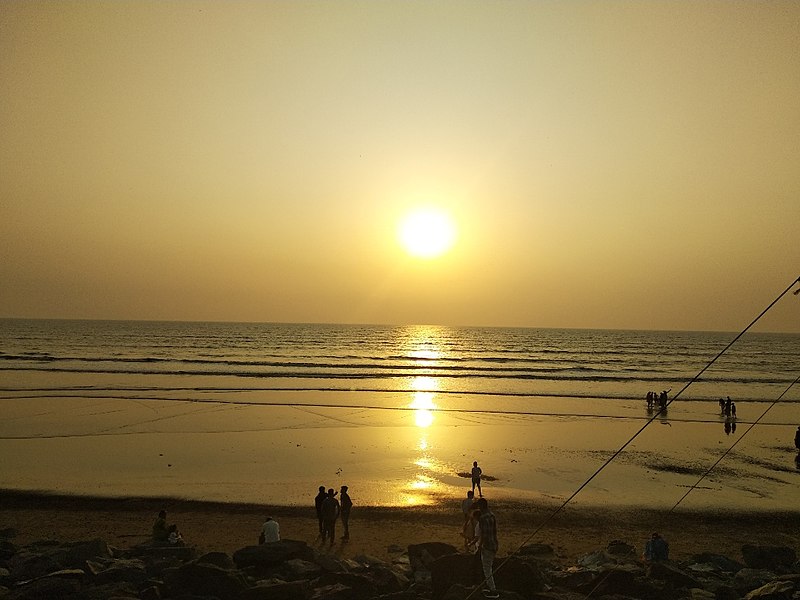Anjuna Beach
Anjuna Beach, situated in North Goa, India, is a renowned coastal destination known for its scenic beauty, vibrant culture, and lively atmosphere.

Image courtesy : wikimedia.org
Location
Anjuna Beach is located in North Goa, approximately 18 kilometers from the state capital, Panaji. It is easily accessible by road and is well-connected to other parts of Goa.
Accessibility
Anjuna Beach is easily accessible by road. The nearest railway station is Thivim Railway Station, and the nearest airport is Dabolim Airport.
Crescent-Shaped Shoreline
Anjuna is characterized by its crescent-shaped shoreline, framed by towering coconut palms. The soft sands provide a perfect setting for leisurely strolls and relaxation.
Flea Market

Image courtesy : goatourism
The Anjuna Flea Market is one of the most famous markets in Goa and is held every Wednesday. It attracts visitors from all over with its diverse array of goods, including clothing, jewelry, handicrafts, and more.
Trance and Hippie Culture
Anjuna Beach gained fame in the 1960s and 1970s as a hub for the hippie movement. The beach was known for its free-spirited atmosphere, attracting travelers seeking an alternative and bohemian lifestyle. The influence of this era is still felt in the vibrant culture of Anjuna.
Cliffside Views
The cliffs overlooking the beach offer stunning panoramic views of the Arabian Sea. These cliffs are popular spots to enjoy the sunset and capture breathtaking coastal vistas.
Shacks and Cafes
Anjuna Beach is dotted with beach shacks and cafes offering a variety of cuisines, from Goan seafood to international fare. Visitors can relish delicious dishes with the sound of waves in the background.
Water Sports and Activities
While Anjuna is not as focused on water sports as some other beaches, visitors can still enjoy activities such as parasailing, windsurfing, and jet-skiing.
Nightlife
Anjuna is renowned for its vibrant nightlife. The beach hosts beach parties and trance music events, drawing partygoers from around the world. Clubs like Curlies and Shiva Valley are popular venues for dance and music enthusiasts.
Chapora Fort

Image courtesy : wikimedia.org
The nearby Chapora Fort offers a historical excursion with panoramic views of the coastline. The fort is known for its association with the Bollywood movie “Dil Chahta Hai.”
Historical Significance
Anjuna Beach in Goa holds historical significance primarily due to its association with the hippie movement of the 1960s and 1970s. During this period, Anjuna Beach became a popular destination for hippies, backpackers, and alternative travelers seeking spiritual enlightenment, cultural exchange, and a bohemian lifestyle.
Hippie Culture: Anjuna Beach gained international fame as a gathering place for hippies from around the world. They were attracted to the beach’s serene ambiance, scenic beauty, and laid-back atmosphere. Hippies would gather on the beach to socialize, play music, practice yoga, and engage in communal living.
Full Moon Parties: Anjuna Beach became famous for its legendary full moon parties, where hippies and travelers would come together to celebrate under the light of the full moon. These parties were characterized by music, dancing, bonfires, and a free-spirited atmosphere. They became iconic symbols of the hippie counterculture and drew visitors from far and wide.
Flea Markets: The tradition of flea markets at Anjuna Beach has its roots in the hippie era. Hippie travelers would set up makeshift stalls to sell handmade crafts, jewelry, clothing, and other items to sustain their nomadic lifestyle. Over time, these flea markets evolved into the vibrant and eclectic markets that are still held in Anjuna today.
Cultural Exchange: Anjuna Beach was a melting pot of cultures during the hippie era, with travelers from different countries coming together to share ideas, experiences, and perspectives. This cultural exchange contributed to the beach’s unique identity as a place of tolerance, acceptance, and open-mindedness.
Music and Art: Anjuna Beach played a significant role in the development of Goa trance music and psychedelic art during the hippie era. Musicians and artists drawn to the beach’s creative energy would collaborate, experiment, and innovate, laying the foundation for the electronic music scene that still thrives in Goa today.
Overall, Anjuna Beach’s historical significance lies in its role as a symbol of the hippie counterculture and a hub for cultural exchange, creativity, and alternative lifestyles during the 1960s and 1970s. While the hippie era has passed, Anjuna Beach continues to attract visitors from around the world who are drawn to its bohemian spirit, vibrant markets, and scenic beauty.





Leave a Reply